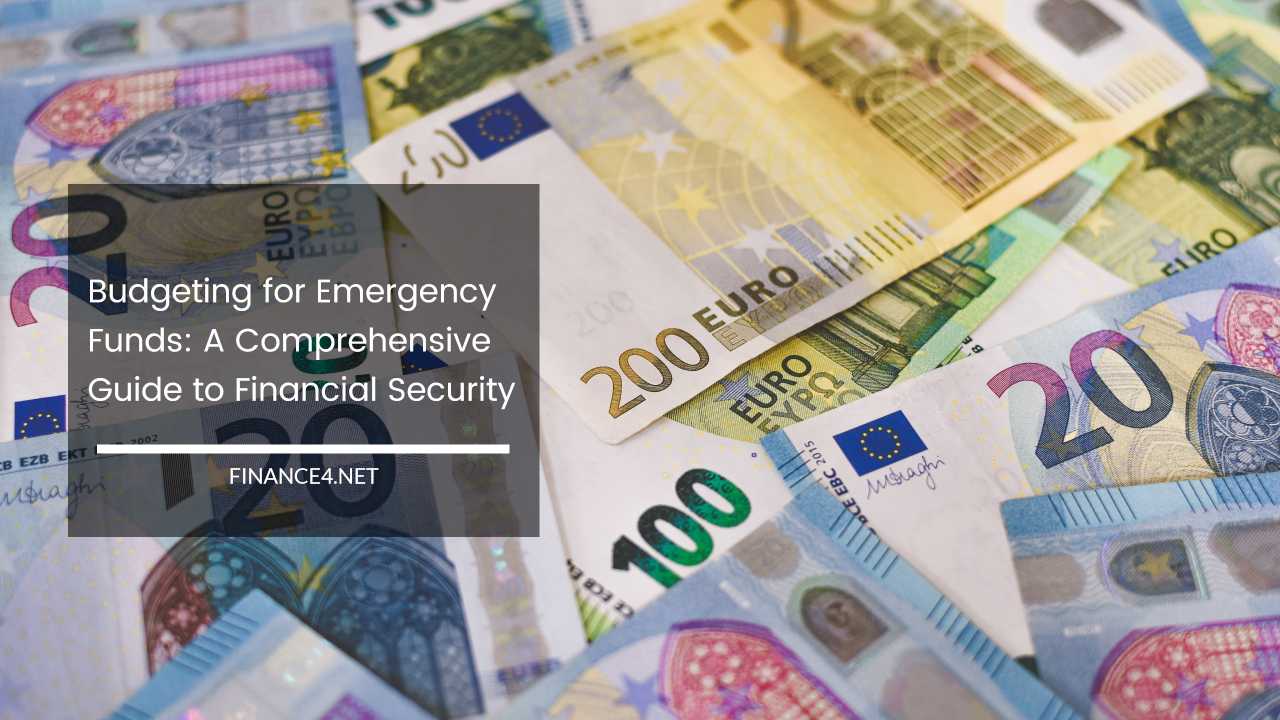Budgeting for Emergency Funds: A Comprehensive Guide to Financial Security

Emergency Funds
Financial stability and security are essential components of a comfortable and stress-free life. One crucial element in achieving this is having an emergency fund.
An emergency fund acts as a financial safety net, providing you with the resources to cover unexpected expenses and emergencies.
In this comprehensive guide, we will explore the importance of budgeting for emergency funds, how to create and maintain one, and the long-term benefits it offers.
1: Understanding the Significance of Emergency Funds
An emergency fund is considered a financial necessity, as it provides you with a buffer against life’s unexpected challenges.
These challenges can manifest as medical emergencies, unexpected home repairs, major car breakdowns, or sudden job loss.
Without an emergency fund, individuals often resort to accumulating high-interest debt on their credit cards to address these unexpected financial burdens. Such debt can take years to repay, ultimately costing far more than the original expense.
An emergency fund, on the other hand, offers a secure financial fallback. It enables you to navigate these unforeseen circumstances without the burden of debt and the associated interest.
When you build an emergency fund, you are essentially creating a financial cushion to soften the blow of unexpected expenses.
2: Building an Emergency Fund
2.1. Setting Monthly Contributions
The process of building an emergency fund begins with setting aside a portion of your income regularly. Experts often recommend allocating an additional thirty to fifty dollars each month to an individual “emergency savings account.”
This contribution should be treated as a non-negotiable monthly expense. By establishing this routine, you can steadily grow your emergency fund over time, ensuring it is available when needed.
2.2. Making It a Financial Priority
Budgeting for an emergency fund should be a significant priority when planning for your financial future. This fund serves as a financial safety net that can help you navigate difficult times.
The goal should be to accumulate savings by incorporating your monthly contributions into your budget. Ideally, your emergency fund should cover at least three months’ worth of living expenses, providing you with a substantial safety cushion.
2.3. The Importance of Consistency
The success of your emergency fund is not determined by the returns or interest earned but by the consistent and steady contribution of funds.
Unlike investments, where growth is often tied to market performance, an emergency fund relies on your discipline in saving a fixed amount of money consistently. This way, you have immediate access to the funds when unexpected expenses arise.
Chapter 3: Budgeting for Your Emergency Fund
Budgeting is a fundamental aspect of managing your finances and making room for an emergency fund. It involves setting aside money for both anticipated and unanticipated future needs.
By establishing a budget, you set financial goals, including creating and maintaining an emergency fund.
3.1. Creating a Detailed Budget
The first step in budgeting for an emergency fund is to gain a clear understanding of your current spending habits.
This involves tracking your income and expenditures, categorizing your expenses, and identifying areas where you can cut costs.
With a detailed budget in place, you can make informed decisions about where to trim expenses and allocate more to your emergency fund.
3.2. Treating the Emergency Fund as a Financial Goal
An emergency fund should be treated as one of your primary financial goals. As you create your budget, prioritize contributions to your emergency fund.
Allocate a specific portion of your income each month to ensure that your fund steadily grows. By treating your fund as a financial goal, you will be motivated to consistently contribute to it.
4: Choosing the Right Account for Your Emergency Fund
4.1. Types of Accounts
When budgeting for an emergency fund, it’s essential to select the right account for storing your funds. Different types of accounts are suitable for various purposes, and your choice should consider factors like accessibility, liquidity, and interest rates.
- Checking Account: A checking account provides easy access to your funds. It is suitable for short-term emergency needs, but it may not offer the best interest rates.
- Savings Account: A savings account offers slightly higher interest rates than checking accounts and is a suitable option for medium-term savings goals. It provides a balance between accessibility and growth.
- Money Market Account: A money market account typically offers higher interest rates than savings accounts. It combines liquidity with the potential for modest growth, making it a good choice for emergency funds.
- Certificates of Deposit (CDs): CDs offer the highest interest rates among these options but come with a fixed term, during which your money is less accessible. They are suitable for funds that you don’t expect to need immediately.
4.2. Liquidity and Accessibility
When budgeting for your emergency fund, consider how quickly you might need access to the money. Emergency situations often require immediate financial support.
Therefore, it’s essential to maintain a balance between growth potential (interest rates) and accessibility. While high-yield CDs may offer excellent interest rates, they may not be the best choice for an emergency fund if you need quick access to your funds.
5: Allocating Funds Saved from Budgeting
5.1. Savings Goal vs. Emergency Fund
The money saved from budgeting can be allocated to different financial priorities. It’s essential to strike a balance between saving for long-term goals and building your emergency fund.
One common approach is to divide your savings into two categories: one portion for your general savings goal and another for your emergency fund.
By splitting your savings in this manner, you simultaneously work towards your long-term financial objectives while building a safety net for unexpected expenses.
5.2. Flexibility and Choice
The allocation of funds from your budget depends on your individual financial circumstances and goals. You have the flexibility to choose how much goes into each category.
For some, the priority may be to amass a significant emergency fund, while others may want to allocate more towards specific savings goals like buying a home, funding education, or retirement.
Ultimately, the choice of how to allocate your funds saved from budgeting is a personal one, and it should align with your unique financial objectives and aspirations.
6: Maintaining Your Emergency Fund
6.1. Regular Review and Adjustments
Maintaining your emergency fund is as important as initially building it. Life circumstances can change, and your financial goals may evolve.
Regularly review your budget and assess whether the amount you contribute to your emergency fund remains adequate. If your income increases or your expenses decrease, consider increasing your monthly contributions to expedite your fund’s growth.
6.2. Only Using It for True Emergencies
One of the key principles of an emergency fund is that it should only be used for genuine emergencies. These emergencies are typically unexpected and require immediate financial support. It’s crucial to refrain from using your emergency fund for non-essential or planned expenses.
6.3. Replenishing the Fund
If you do need to dip into your emergency fund to cover a legitimate emergency, make it a priority to replenish the withdrawn amount as soon as possible. This ensures that your fund remains intact and ready to provide for future unforeseen circumstances.
7: The Long-Term Benefits of Budgeting for Emergency Funds
7.1. Financial Peace of Mind
Budgeting for an emergency fund provides you with a sense of financial security and peace of mind. Knowing that you have a financial safety net in place can reduce stress and anxiety, allowing you to focus on your long-term financial goals without the constant worry of unexpected expenses.
7.2. Protection from Debt
One of the primary advantages of an emergency fund is its ability to shield you from high-interest debt.
Without such a fund, individuals often resort to credit cards or loans to cover unexpected expenses, leading to substantial debt that can take years to repay. An emergency fund prevents this scenario by allowing you to address emergencies without accumulating debt.
7.3. Flexibility and Control
Budgeting for an emergency fund provides you with greater financial flexibility and control. You can handle unexpected expenses without disrupting your long-term financial plans.
This flexibility ensures that you stay on track with your financial goals, whether they involve buying a home, saving for retirement, or pursuing other significant life objectives.
7.4. Opportunities for Growth
In the long term, an emergency fund can also offer opportunities for financial growth. By maintaining a financial safety net, you can take calculated risks, such as investing in higher-returning assets, without fearing the repercussions of unexpected expenses. This can lead to increased financial stability and wealth accumulation over time.
8: Final Remarks
Budgeting for an emergency fund is an essential aspect of achieving financial security and stability. It provides a safety net that protects you from the financial consequences of unexpected expenses and emergencies.
By making it a financial priority, consistently contributing to your fund, and choosing the right type of account, you can create a robust emergency fund that offers peace of mind and the freedom to pursue your long-term financial goals.
In summary, an emergency fund:
- Acts as a financial safety net.
- Protects you from high-interest debt.
- Offers financial flexibility and control.
- Provides opportunities for growth.
By following the principles outlined in this guide, you can create and maintain an emergency fund that supports your financial well-being and helps you navigate life’s uncertainties with confidence.



